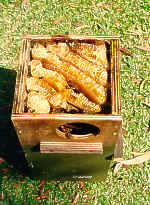Nestbox pests:
Indian myna - the problem
Indian myna - prevention
Indian myna - control
Feral bees - the problem
Feral bees - control
Brushtail possums
Ants
| European honeybees in nestboxes |
|
|
| Home / Contact us / Product range / Stories / Pest management / Prices |
| Virtually all of the commercial honey in
Australia is produced by introduced bees. These same bees are also responsible for
pollinating many of the introduced crops on which we depend for food. Unfortunately, there is also a downside to this story. Many
bees have escaped from hives and colonised tree hollows. Their impact can be gauged
from the honeycomb that has been built in the nestbox illustrated. |
|
The impact of bees varies with locality. In one study in box-ironbark woodlands in central Victoria, 22 of 44 artificial hollows were invaded by bees over a 4 month period during 1993/94. After removing the bees, some hollows were found to contain eggs or dead chicks beneath the honeycomb. In
Brisbane, 4-5 nestboxes per 100 are invaded by feral bees every year, resulting in at
least 10%-20% of all hollows unavailable for use by native animals at any point in time.
However, this figure also varies greatly between sites. On some sites we have
experienced figures similar to those quoted above for Victoria, while on others there have
been no invasions over many years. |
|
| Robert Irvine and
Robert Bender, in a 1997 paper, stated that "recent studies also have indicated that
fitting loose carpet to the roof of artificial hollows may stop bee infestation but
studies are only at the preliminary stage".
We trialled fitting a carpet square to the underside of a number of nestbox lids over a period of 4 years. While initially appearing successful, the subsequent failures suggest that this is little better than doing nothing. Reference: IIrvine, R. and Bender, R. (1997) "Introduction of the sugar glider Petaurus breviceps, into re-established forest of the Organ Pipes National Park, Victoria", The Victorian Naturalist, 114 (5), 230-239. |
|

